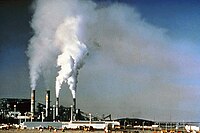
Photo from wikipedia
Experiments were conducted in a simulated wet flue gas desulfurization (WFGD) system to investigate the effects of sulfite, slurry temperature, pH value and atmosphere on mercury migration and re-emission. The… Click to show full abstract
Experiments were conducted in a simulated wet flue gas desulfurization (WFGD) system to investigate the effects of sulfite, slurry temperature, pH value and atmosphere on mercury migration and re-emission. The mechanisms were discussed based on the kinetics and chemical equilibrium. The results indicate that SO32− is a key factor for Hg0 re-emission in WFGD system. Increasing SO32− concentration at a relatively low level can promote Hg2+ in liquid phase reducing to gaseous Hg0, whereas Hg0 re-emission is significantly inhibited with excess SO32−. The reaction rate of mercury reduction is calculated to increase by approximately ten times when the slurry temperature rises from 40 to 60 °C. It reveals that a higher slurry temperature can accelerate mercury reduction. The proportion of mercury in liquid phase is detected to decline sharply with a drop in pH value. The mechanisms were further proposed that SO32− tends to be protonated and the stabilities of mercury–sulfite complexes are weakened at low pH value. Under both N2/O2 and O2/CO2 atmospheres, increasing O2 concentration can suppress Hg0 re-emission. However, the variation in CO2 concentrations has no impact on Hg0 re-emission. Compared with O2/CO2 atmosphere, there is more Hg0 re-emission under N2/O2 atmosphere due to the secondary release of Hg0.
Journal Title: International Journal of Environmental Science and Technology
Year Published: 2020
Link to full text (if available)
Share on Social Media: Sign Up to like & get
recommendations!